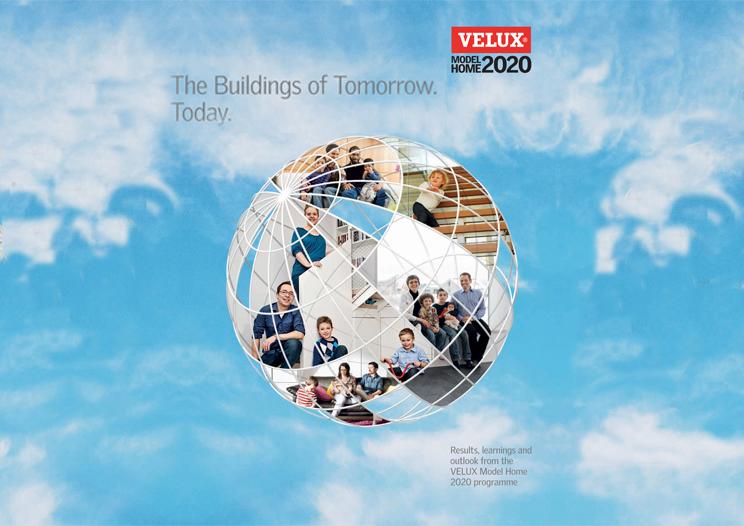VELUX shares the lessons learned from Model Home 2020

Following the motto of its founder Villum Kann Rasmussen “One experiment is better than a thousand expert views”, the VELUX Group publishes the results of its Model Home 2020 programme. This experimentation aims to demonstrate that sustainable living can be achieved in a home environment that prioritises naturalventilation and large fenestration.
The VELUX Group made its mission to find solutions combining and benefitting both energy efficiency and comfort of the residents. Recently, VELUX released a study, the Healthy Home Barometre, which reveals the concern of Europeans with indoor air quality and the impact of their homes on their health. With the Model Home 2020 report, the VELUX Group demonstrates that there are solutions to match that need.
In 2009, VELUX launched the Model Home 2020 programme according to the Active House vision of buildings: healthier, more comfortable buildings without negative impact on the environment. In Austria, Denmark, United Kingdom, France and Germany, 6 experimental buildings have been built on these principles and lived in by test families for 12 months. , the VELUX Group demonstrates that there are solutions to match that need.
These houses are also part of the 221 demo-houses of the Active House network, located in 12 countries, from the United States to Russia.

The comeback of nature
All houses achieved a notable daylight factor of at least 5%, exceeding most national standards by a factor of 3-5. Furthermore, residents registered one more hour of daylight between sunrise and sunset, and evel led to some family members accepting natural lighting levels as low as 50 lux without turning on artificial illumination. In one instance, the power consumption for lighting was halved to a mere 1.7 kWh/m2a.
When talking about increasing the daylight factor, we usually think large window areas. Model Home 2020 houses are no exception and their window areas comprise 30-50% of the living area, is key to achieving these levels of natural daylight. However, it also raises the concern of excessive heating due to solar influx in the warmer seasons. This challenge was successfully addressed by applying natural ventilation and protective sunscreening to each model home. Measurements showed that automated night-time ventilation alone was capable of cooling down the indoor temperatures from 26°C in the evening to around 20°C the next morning.
All in all, the results support the notion that beneficial outdoor properties can be put into effect inside a modern home without compromising the principles on which the future of sustainable building relies. They even describe a home concept that, for the first time in centuries, happens to be supportive of our very own nature
Lessons for the future
Based on hard data from built-in information systems and interviews with the volunteer residents, a valuable corpus of insight into the mechanisms and capabilities of the 21 demo houses’ has been gathered, generating common denominators to be examined and utilised in future projects. Most significantly, this is what we’ve learned so far
 |
Residential buildings can meet the energy targets of 2020 with the knowledge, technology and building components of today. |  |
Hybrid ventilation performs well, combining automated window operation and mechanical ventilation systems with manual window operation. Rather than being active at the same time, the two modes of operation should depend on outdoor temperature. |
 |
There is no conflict between 2020 energy targets and high daylight levels in low-energy buildings. |  |
Residents will grow accustomed to automation and learn to appreciate its benefits. |
 |
Low energy buildings with high daylight levels can achieve good thermal performance, using window openings and solar shading to avoid excessive summer heating. |  |
It is possible to achieve great daylight conditions without summer over-heating in low-energy buildings. |
 |
Natural ventilation and shading can increase summer comfort. |  |
Daylight conditions are a top-level asset. Feedback from residents shows an appreciative attitude to good daylight conditions – a positive benefit that came as a surprise to many. |
 |
Sunscreening in combination with ventilative cooling and particularly night ventilation is an effective double-strategy to achieve increased summer comfort. |  |
It is possible to have sufficient illumination with daylight (daylight autonomy) between sunrise and sunset, regardless of season. |
 |
Building automation is becoming increasingly important in future homes as energy-efficient buildings react faster to solar gains. The systems must provide feedback to residents |  |
The design principles used in the Active Houses may provide more benefits than those that can be easily quantified, as the residents reported better sleep, improved well-being and reduced asthmatic symptoms. |
Find out more about the Model Home 2020 programme and its results. Download the report.
Try and try again
90% of the building stock that we will be using in 2050 has already been built. Knowing that, the VELUX Group decided to extend its experimentation to sustainable renovation. On May 26, was launched the RenovActive Project in Belgium as part of the Active House demo-houses. The objective of this project is to prove that the vision of comfortable and nearly-zero-energy buildings can be achieved in a way that is cost effective, scalable and reproducible. http://www.velux.be



